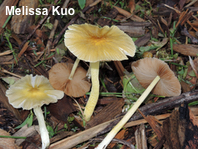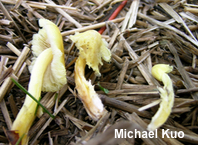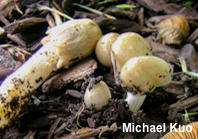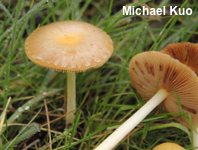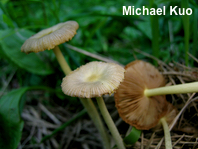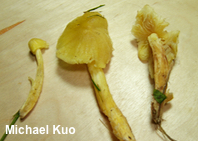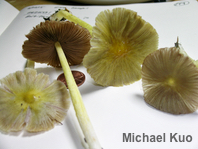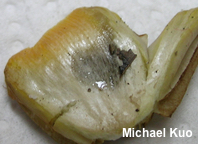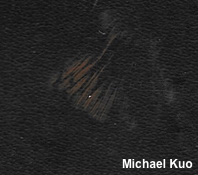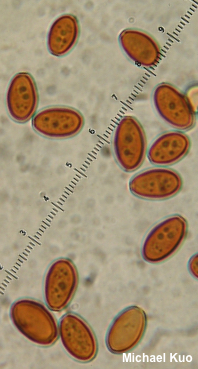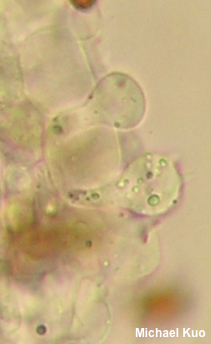| Major Groups > Gilled Mushrooms > Dark-Spored > Bolbitius > Bolbitius titubans |

|
[ Basidiomycota > Agaricales > Bolbitiaceae > Bolbitius . . . ] Bolbitius titubans by Michael Kuo, 18 May 2024 This widespread and common mushroom is quite variable in its color, size, and stature. Young specimens often have a distinctive, yellow, egg-shaped cap—but the short-lived Bolbitius titubans soon begins to fade and expand, becoming brownish and convex, and eventually more or less flat. Robust specimens are found on dung and in heavily fertilized soil, while flimsy specimens can be found in grassy areas with less nitrogen. The not-so-variable features, which should probably be relied on for accurate identification, include:
"Bolbitius titubans" as I am treating it here is a species group awaiting contemporary taxonomic study. Several species were described before the advent of DNA studies, based on putative morphological differences (overall size, the shade of yellow, how much yellow appears on the stem, and so on), including Bolbitius fragilis, Bolbitius variicolor, and Bolbitius vitellinus. My North American collecting experience leads me to believe that these morphological differences are inconsistent, and do not always correlate with other features in the way they "should." In the only contemporary study of the titubans group I'm aware of (Malysheva et al. 2015), the researchers found support for four "subclades" within Bolbitius titubans, looking primarily at Russian specimens, and concluded that the species "is clearly a complex of different morphotypes, also supported phylogenetically, but the question of whether the members of this complex represent independent taxa will require further research." Description: Ecology: Saprobic, growing alone, scattered, or gregariously on dung, on compost, on straw, and in fertilized grass; summer and fall, and over winter in warm climates; originally described from France (Bulliard 1789); widely distributed in Europe and in North America; documented in Oceania, and reported from South America and Africa. The illustrated and described collections are from California and Illinois. Cap: 2.5–6 cm across; egg-shaped or nearly round when young, expanding to broadly convex, and eventually flat with a depressed central bump; thin and fragile; sticky when fresh; yellow to brownish yellow or greenish yellow at first, becoming olive yellow to brownish yellow and, eventually, brownish to pale tan; bald; usually strongly lined by maturity, often nearly all the way to the center. Specimens developing a pocketed or veined cap surface as the stickiness dries out are sometimes encountered. Young specimens sometimes display a felty, whitish cap margin, but this appears to be the result of contact with the stem (which also features the feltiness) in the button stage, rather than remnants of a true partial veil. Gills: Narrowly attached to the stem; close; short-gills frequent; fragile and soft; whitish or pale yellowish, becoming dull cinnamon; often gelatinizing somewhat in wet weather. Stem: 3–12 cm long; 3–6 mm thick; equal; hollowing; fragile; finely scaly, powdery, or finely hairy when young—but often becoming more or less smooth; white with a yellowish apex and/or base, or yellowish to yellow overall; basal mycelium white. Flesh: Insubstantial; yellowish to whitish; not changing when sliced. Odor: Not distinctive. Chemical Reactions: KOH on cap surface negative to slowly dark gray. Spore Print: Dull cinnamon brown. Microscopic Features: Spores 11–15.5 x 7–9 µm; ellipsoid, with one end flattened for a 1–2 µm pore; smooth; thick-walled; orangish brown in KOH. Basidia 25–28 x 10–12 µm; abruptly clavate; 4-sterigmate. Brachybasidioles present. Cheilocystidia 25–50 x 10–25; µm; saccate to irregularly cylindric or lageniform; smooth; thin-walled; hyaline in KOH. Pleurocystidia not found. Pileipellis hymeniform; terminal cells 25–38 x 7.5–15 µm; clavate to obpyriform; smooth; hyaline in KOH. Clamp connections not found. REFERENCES: (J. B. F. Bulliard, 1789) E. M. Fries, 1838. (Fries, 1821; Atkinson, 1900; Kauffman, 1918; Smith, Smith & Weber, 1979; Phillips, 1981; Watling, 1982; Arora, 1986; Schalkwijk-Barendsen, 1991; Hansen & Knudsen, 1992; Lincoff, 1992; Breitenbach & Kränzlin, 1995; Barron, 1999; Hemmes & Desjardin, 2002; Arnolds, 2005; McNeil, 2006; Miller & Miller, 2006; Buczacki et al., 2013; Kuo & Methven, 2014; Desjardin, Wood & Stevens, 2015; Evenson, 2015; Malysheva et al., 2015; Siegel & Schwarz, 2016; Baroni, 2017; Gminder & Böhning, 2017; Wood & Dunkelman, 2017; Knudsen & Vesterholt, 2018; Sturgeon, 2018; Læssøe & Petersen, 2019; McKnight et al., 2021.) Herb. Kuo 08300401, 01120607, 05080901, 05281101, 03231201, 06181503, 06201501, 01111802, 05162401. This site contains no information about the edibility or toxicity of mushrooms. |
© MushroomExpert.Com |
|
Cite this page as: Kuo, M. (2024, May). Bolbitius titubans. Retrieved from the MushroomExpert.Com Web site: http://www.mushroomexpert.com/bolbitius_titubans.html |


